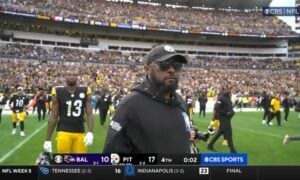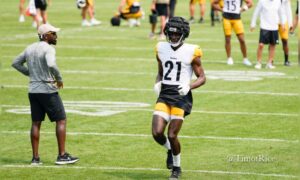As we’ve done sporadically throughout the season, we’ll go through our final master defensive chart for the final time. We’ll highlight some of the most interesting tidbits the charting told us. Sorted by position below.
If you are curious about a stat/figure that you don’t see below, feel free to ask in the comments and I will try to answer it.
Keep in mind this is only for the regular season. Excluding penalties that wiped out the play entirely, the Pittsburgh Steelers’ defense had 944 snaps.
OVERALL
– The Steelers used their base 3-4 defense slightly more than nickel for the entire year. 472 to 454, respectively.
– But in the second half of the season, nickel was used more often. 247 to 213 (52.7% to 45.5%).
– 412 of 944 snaps took place in Steelers’ territory. That’s just under 44%. The highest percentage in a single game came in a Week Two loss against the Baltimore Ravens. They ran 42 of 65 snaps across midfield, 64.6%. The lowest occurred in Week 13 against the New Orleans Saints. They ran just 13 plays on 54 snaps, 24.1%. Makes it all the more bizarre they put up 35 points in a victory.
– Although this is a relative number and you’d need league wide statistics to determine how “good” this number is, it looks strong. The Steelers defense held their own in third and short. On third and less than four, the Steelers stopped the offense short 52.8% of the time.
– On third and one, opposing offenses converted just eight times on 18 opportunities. A little over 44%.
– Across 599 passing chances (combining attempts, sacks, and scrambles) the Steelers sent three or fewer rushes 65 times. Rushing four was their most popular option, often having an OLB drop into coverage or rushing a vanilla four in nickel. They did so 264 times. Rushing five came in second place with 167. The Steelers rushed 6+ 33 times.
-Throughout the year, I considered a blitz to be a defender rushing the QB who wasn’t on the defensive line or playing outside linebacker.
Of the 599 chances, I have the Steelers blitzing on 168 of them, 28% of the time. Two of the top three blitzing games came in Weeks 8 and 9 against the Indianapolis Colts and the Baltimore Ravens, where they saw some of their best pressure. The score had a lot to do with that though.
However, the Steelers didn’t always need to blitz to get to the QB. They blitzed 11 times versus the Kansas City Chiefs and wound up with six sacks. Eleven is right in line with the team average.
– To break down the blitzes further, the Steelers sent just one or more defensive back – no linebacker – 44 times.
– At least one linebacker – and no DB – was sent 104 times. An additional 22 blitzes came with the defense blitzing a combination of a linebacker and defensive back.
– Lawrence Timmons blitzed the most of anyone, doing so 60 times. He blitzed in nine different combinations of players, also highest among the defense.
– Troy Polamalu blitzed by himself or in tandem a total of 32 times.
– As you’d expect, opposing offenses were more successful running to their right, the defense’s left, than vice versa. Averaged 4.7 YPC to their right, 3.8 to their left.
DEFENSIVE LINE
– Although we’re not focusing on the playoff game, it is worth noting Daniel McCullers played a season high in snaps last Saturday with 17. He never had more than 13 over the regular season. Sample size is still awfully small. Even if you include the playoff game, he racked up just 74 snaps in 2014. Only once did he play more than three consecutive snaps before subbing out.
– The perils of being a rookie. Stephon Tuitt played six different techniques his rookie year, as all Steelers’ ends are asked to do. LDE, LDT, LOLB (subpackage where he is the EMOL with his hand up), NT, RDT, RDE.
It’s the reason why those players get limited. Lot to absorb.
– But his snap count had a meteoric rise in the last quarter of the season. Of his 372 overall snaps, 247 came following the bye. That’s nearly two-thirds over a 25% span.
For comparison, over the same timetable, Cam Thomas logged 72.
– Cameron Heyward is a manimal. Doesn’t come off the field. Played 87% of the time and never missed more than five consecutive snaps. And that’s something that happened just three times over 2014.
– You guys love hearing about the YPC allowed with the different nose tackles in. So here you go. We’ll start with the overall number while they were on the field, regardless of the direction the ball was run.
Daniel McCullers: 3.9
Steve McLendon: 4.3
Cam Thomas: 4.7
McCullers’ also includes a 31 yard Mark Ingram run, making it more impressive.
To specify it a bit more, we’ll break it down again showing only runs between the tackles.
Daniel McCullers: 6.0
Steve McLendon: 3.2
Cam Thomas: 3.8
Should be noted the 31 yarder came back to haunt McCullers here. With a sample size of just 12 runs, it does skew the number pretty good.
In both categories, McLendon’s numbers are fairly solid. Especially the latter. Offenses don’t run for so little if they can move the nose tackle around. That didn’t happen with McLendon.
The Steelers are set at nose tackle.
– McLendon has played one snap at end in the base defense over the last two years.
– Tuitt’s snaps primarily came on the left side, be it end or tackle. 344 of 372 (92.5%).
– Ditto with Thomas. 235 on the left compared to 29 on the right. He also saw 157 snaps at nose tackle. 157 too many for Steelers’ fans.
LINEBACKERS
– Arthur Moats was phased out of the defense after the bye week, seeing 60 snaps across five contests.
– Terence Garvin saw 11 snaps on defense. They all came in goal line packages.
– In the final two weeks with Ryan Shazier back and logging starters’ snaps, Vince Williams’ playing time took a dip. Averaged just 16 per game. Shazier averaged 29.
– And in the playoff game, he was held to nine snaps. Sean Spence got 20 and Shazier 25.
– I was really surprised to see Williams only receiving 20 snaps in the Steelers’ base defense. Much lower than I would have guessed. Was really just a nickel defender.
– What to do with Jason Worilds is a big point of contention. He may not had produced like some had hoped but he sure did log lot of snaps. Led the team. Didn’t miss a snap until the 410th play of the year, coming in Week Seven against the Houston Texans. And for the regular season, he never missed more than three consecutive plays.
– He was also used creatively, picking up 77 snaps at inside linebacker. Almost always in subpackage defenses. 50 of his 77 came with 7+ yards to go.
– Lawrence Timmons recorded 41 snaps at OLB in 2014.
– Excluding the two games he missed, following the bye week, James Harrison got over 92% of the snaps at ROLB. Jarvis Jones and Moats were left with scraps. 5.8 and 1.6 percent, respectively.
– After Jones’ wrist injury in Week Three, he would only play 73 more snaps on the year. Has to show something in 2015.
SECONDARY
– As we’ve looked at each time in one of these articles, we’ll show the notable “target” stats. As I always do, want to make it clear I have been generous to defenders in what constitutes a target. To get rid of the guessing game of coverages and assignments, for this year I only counted it as a target if a player was so obviously beat or had an opportunity to make a play on the ball and break up/intercept the pass.
Because of that, my numbers will likely look much smaller than other websites. But I didn’t want to fault a corner playing the deep third in Cover 3 for “allowing” a seven yard curl.
It’s a stat I’ll reevaluate for next year and possibly change how I track it.
William Gay: 15/35 365 yards 2 TD 3 INT (all returned for TDs)
Cortez Allen: 21/34 380 yards 5 TD 2 INT
Antwon Blake: 8/14 105 yards 4 TD 1 INT
Brice McCain: 5/11 117 yards 0 TD 2 INT
Ike Taylor: 6/9 145 yards 2 TD
– Love to see Gay’s completion percentage so low. Under 43%. He did, unfortunately, allow over 24 yards per catch.
– Allen gave up two fewer touchdowns than the rest of the Steelers’ cornerbacks combined. Obviously, that’s disappointing. A near 62% completion percentage doesn’t make anyone feel better, either.
– Blake’s lack of size sure showed up near the goal line. Three of the four touchdowns allowed came inside the five.
– Statistically, McCain’s numbers look pretty spectacular. Low completion percentage, the only corner not to allow a TD, and two interceptions to his credit.
– No one expected McCain to play as much as he did. 577 total snaps. 395 in the slot as the nickel back with another 182 coming outside, mostly at left corner. He held his own. Steelers really needed his services.
– In a season where it was difficult to play defensive back without getting flagged, Gay was penalized only once. The infamous taunting call against the Kansas City Chiefs.
– Cortez Allen was flagged nine times. For him, that works out to a flag every 32 plays.
– A narrative buster, perhaps? Mike Mitchell was flagged just four times in the regular season. The same amount as McCain. And less than Polamalu, who had six penalties.
– The Steelers’ secondary did a tremendous job of playing clean football. Taylor and Cortez aside, the rest of the secondary combined for six pass interferences, defensive holding, and illegal contact calls COMBINED.
Opposing offenses nearly had as many pass interferences called against them (3) as the entire Steelers’ defense in 2014 (4).
– Over the final seven games, Pittsburgh had a grand total of two defensive holding or pass interference calls. Two over 263 dropbacks. That has to be the lowest total in the league.
– And Taylor and Cortez? They combined for seven holding/interferences. Toss in two more illegal contacts on Allen for good measure.
– Shamarko Thomas played two snaps this year. Both came in Week 17 against the Cincinnati Bengals.
– Ross Ventrone was the only regularly active Steelers’ defender not to play a single snap on defense. I’m disappointed, LeBeau.








